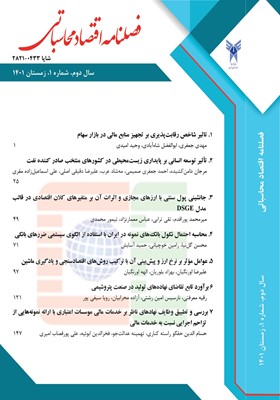برآورد تابع تقاضای نهاده های تولید در صنعت پتروشیمی
محورهای موضوعی : فصلنامه اقتصاد محاسباتی
رقیه معرفتی
1
*
,
نارسیس امین رشتی
2
,
آزاده محرابیان
3
![]() ,
رویا سیفی پور
4
,
رویا سیفی پور
4
1 - دانشجوی دکتری علوم اقتصادی ،دانشگاه آزاد اسلامی ، واحد تهران مرکزی ، تهران ، ایران
2 - استادیار ، گروه اقتصاد دانشگاه آزاد اسلامی ، واحد تهران مرکزی ، تهران ، ایران
3 - استادیار ، گروه اقتصاد دانشگاه آزاد اسلامی ، واحد تهران مرکزی ، تهران ، ایران
4 - استادیار ، گروه اقتصاد دانشگاه آزاد اسلامی ، واحد تهران مرکزی ، تهران ، ایران
کلید واژه: تقاضای نهاده, , , , , صنعت پتروشیمی, , , , , انرژی, , , , , سیستم معادلات همزمان,
چکیده مقاله :
هدف پژوهش حاضر بدست آوردن تابع تقاضای نهاده های تولید در صنعت پتروشیمی است. سوال اصلی این مطالعه مربوط به اثر و سهم هر یک از عوامل تولیدی در هزینههای پرداختی در صنعت پتروشیمی بوده است. روش تحقیق در این مطالعه مبتنی بر تحلیلی – توصیفی و استفاده از روش سیستم معادلات همزمان بوده است. به منظور آزمون رابطه بین متغیرها از اطلاعات دوره زمانی 1399-1375 استفاده شده است. نتایج این تحقیق نشان داد که رابطه بین سهم عامل تولید مواد اولیه در کل هزینه پرداختی به عوامل تولید و قیمت نسبی نیروی کار، مواد اولیه و مواد اولیه و محصول مثبت و رابطه آن با قیمت نسبی ماشین آلات و انرژی منفی است. نتایج کششهای جایگزینی نیز نشان میدهد که سرمایه با نیروی کار، مواد خام با نیروی کار و سرمایه با انرژی ورودیهای جایگزین (کشش جایگزینی بیشتر از صفر)، سرمایه با مواد خام، مواد خام با انرژی ورودیهای مکمل (کشش جایگزینی کمتر از صفراست). بر این اساس می توان گفت که رابطه جانشینی بین مواد خام و نیروی کار و نیروی کار و همچنین رابطه مکمل بین مواد خام و سرمایه نسبتاً قوی تر از سایرین است.
The aim of the current research is to obtain the demand function of production inputs in the petrochemical industry. In order to test the relationship between the variables, the information of the time period 2015-2018 has been used. The statistical population of this research is the companies that produce petrochemical products. The results of this research showed that the relationship between the share of raw material production factors in the total cost paid to production factors and the relative price of labor, raw materials and raw materials and products is positive and its relationship With the relative price of machines. and energy is negative. The results of substitution elasticities also show that capital with labor, raw materials with labor and capital with energy are alternative inputs, capital with raw materials, raw materials with energy are complementary inputs. In the estimated cross elasticities, see It was found that the price elasticity of raw materials is higher than other inputs in terms of absolute value, in other words, the demand for raw materials is more sensitive to price changes than other inputs. The inputs of capital, labor and energy are in the next ranks in this field. Also, the absolute value of the numerical value of the price elasticities of all inputs is less than one, and therefore it can be said that the demand for all inputs is inelastic.
_||_

